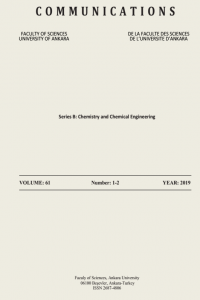THE EFFECT OF ORGANIC COMPOUNDS ON THE CORROSION OF ZINC IN AQUEOUS SOULTIONS
Bu çalışmada, çinkonun HCl, NaOH ve NaCl ortamlarındaki korozyonuna BTA, TTA, Benzo c Sinnolin, Benzo c Sinnolin 5-oksit, 2,2′ -Dinitro Benzidin ve 2-Aminobenzo c Sinnolin organik maddelerin etkisi araştırılmıştır. Bu konunun belirlenmesinde amaç daha önceki çalışmada bakırın triazollerle inhibitör etkinliğini olumlu yönde etkilemesidir. Ayrıca azot ve kükürt bileşiklerinin çinkonun korozyonunu azaltıcı etkisi olabileceği ileri sürülmüştür. Bu nedenle bu etkiyi net olarak belirlemek için değişik pH’daki sulu çözeltilerine inhibisyon etkinliği belirlenmiştir. Bu amaçla inhibitör içeren ve içermeyen sulu çözeltilerindeki akım yoğunluğu-potansiyel eğrilerinden yararlanılarak korozyon hızları elektrokimyasal yolla belirlenmiştir. Belirlenen bu korozyon hızlarından da inhibitör etkinliği hesaplanmıştır. Bulunan sonuçlardan benzotriazol ve tolitriazolün HCl, NaOH ve nötr ortamlarındaki çinko metaline korozyonunda inhibitör olarak kullanılabileceği ve sinnolinler ise sadece NaOH ortamda inhibitör etkisi gösterdiği bulunmuştur.
THE EFFECT OF ORGANIC COMPOUNDS ON THE CORROSION OF ZINC IN AQUEOUS SOULTIONS
The effect of benzotriazole BTA , tolytriazole TTA , benzo c cinnoline E1 , benzo c cinnoline 5-oxy E2 , 2,2-dinitro benzidyn E4 and 2-Aminobenzo c cinnoline E5 , were investigated on the corrosion of pure zinc metal in four different aqueous solutions. The corrosion rates of the species were determined by electrochemical current density-potential curves. Primary studies have shown that BTA and TTA have inhibitory effect on copper, and compounds containing nitrogen and sulphur reduce the corrosion rate of zinc. The inhibition efficiencies were studied at different pH values in order to clarify the effect of organic compounds. The results revealed that BTA and TTA act as effective inhibitors on zinc in HCl, NaOH and NaCl solutions. Cinnolines were only effective in NaOH solution.
Keywords:
Corrosion, Zinc, Inhibition,
___
- [1] Weast R C, Handbook of Chemistry and Physics. 53 rd ed., The Chemical Rubber Co., Cleveland, Ohio, 1972, p. 0-111-116
- [2] Aramaki K., The inhibition effect of chromate-free, anion inhibitors an corrosion of zinc in aerated 0.5M NaCl, Cor.Sci., 43 (2001), 591.
- [3] Aramaki K., Self-healing mechanism of protective film prepared on a Ce(NO3)- pretreated zinc electrode by modification with Zn(NO3)2 and Na3PO4, Cor.Sci., 45 (2003), 1085.
- [4] Robert P. Socha, Jan Fransaer. Mechanism of formation of silica-silicate thin films on zinc, Tihn Solid Films., 488 (2005), 45.
- [5] Amin M. A, Passivity and passivity breakdown of zinc electrode in aerated neutral sodium nitrate solutions, Electrochim. Acta, 50 (2005), 1265.
- [6] C.G. da Silva, A.N. Correia, P. de Lima-Neto, I.C.P. Margarit, O.R. Mattos, Study of conversition coatings obtained from tungstate-phosphoric acid solutions, Cor. Sci., 47(2005), 709.
- [7] Aramaki K, The effect of modification with hydrogen peroxide on a hydrated cerium (III) oxide layer for protection of zinc against corrosion in 0.5M NaCl, Cor.Sci.,48 (2006), 766.
- [8] Song Y.K., Mansfeld F., Development of a molybdate-phosphate-silane-silicate (MPSS) coating process for electrogalvanised steel, Cor. Sci., 48 (2006), 154.
- [9] Wang K., Pickering H. W., and Weil K. G., 2003 Corrosion inhibition of zinc benzotriazole with an electrochemical quartz crystal microbalance, Journal of Electrochemical Society (ECS), 150, B176-B180.
- [10] Antonijevic M. M., Miliç S. M., Petroviç M. B., Film formed on copper surface in chloride media in the presence of azoles, Cor. Sci., 51 (2009),1228.
- [11] Aljourani J., Raeissi K., Glozar M. A., Benzimidazole and its derivatives a corrosion inhibitors for mild steel in 1M HCl solution, Cor. Sci., (2009) (in press).
- [12] Antonijevic M. M. and Petroviç M. B., Cooper Corrosion inhibitors, Int. J. Electrochem. Sci., 3 (2008) 1-28.
- [13] Zhang Y. N., Zi J. L., Zheng M. S. and Zhu J. W., Corrosion behaviour of copper with minor alloying addition in chloride solution, J. Alloys and Compounds 462 (2008)240-243.
- [14] Mountassir Z. And Shiri A., Elektrochemical behaviour of Cu-40Zn in 3% NaCl solution polluted by sulphides, effect of aminotriazole, Cor. Sci. 49 (2007) 1350-1361.
- ISSN: 1303-6017
- Başlangıç: 1948
- Yayıncı: Ankara Üniversitesi
